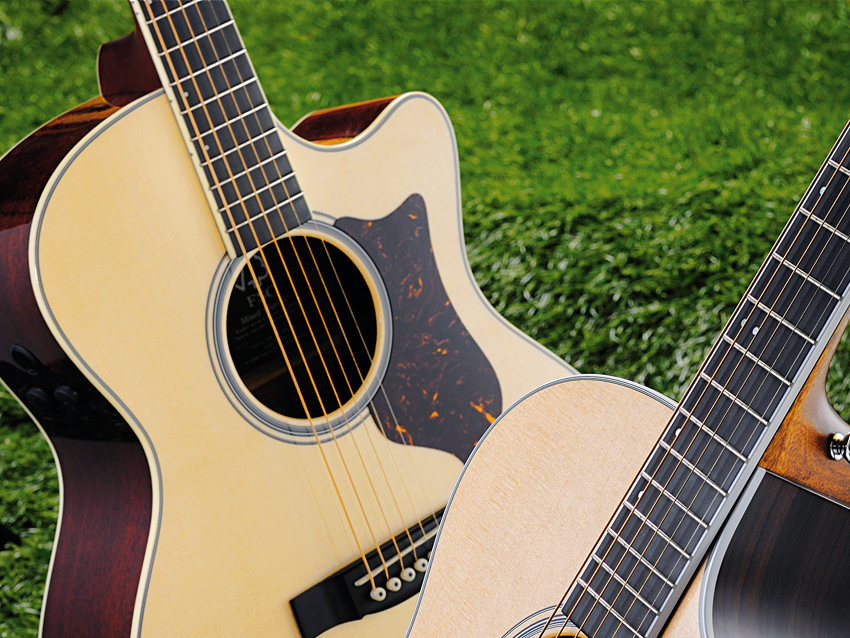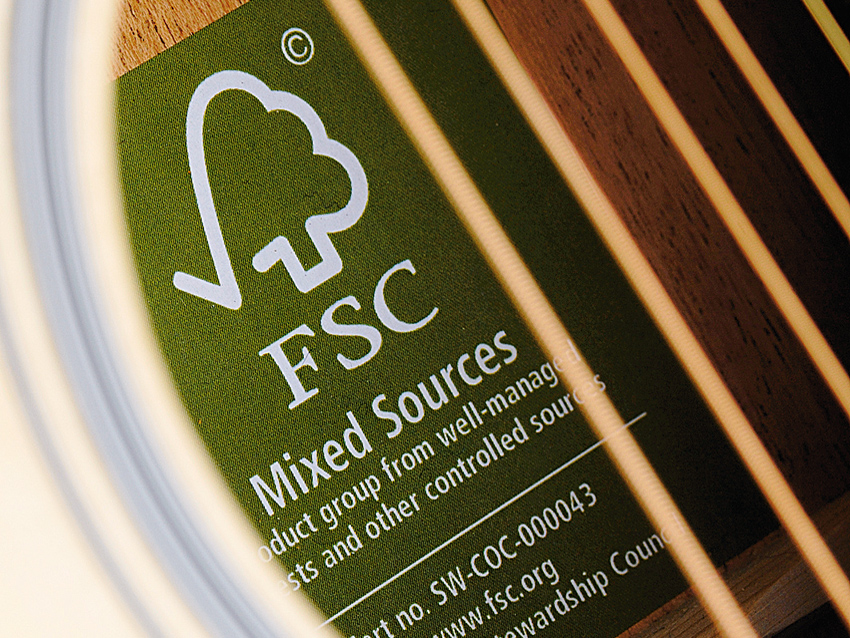MusicRadar Verdict
For those looking for more punch than your average electro, this offers it in abundance, with green credentials to boot.
Pros
- +
Eye-catching looks. Great all-round tone.
Cons
- -
F1 learning curve. Price.
MusicRadar's got your back

Martin GPCPA Mahogany

Martin GPCPA Mahogany

Martin GPCPA Mahogany

Martin GPCPA Mahogany
Martin has been making guitars now for more than 175 years - well before anyone ever considered plugging one in. Yet the release of new models within the Performing Artist Series of electros gives evidence of its desire to look to the future rather than back at its past.
Launched at Winter NAMM 2010, the GPCPA1 was generally well received. But its price tag of £3,200 made what was a desirable guitar unattainable for the majority of those that would arguably make best use of its F1 Aura 'sound reinforcement' electro system.
"This offers a dry, woody, mid-biased timbre particularly well suited to blues fingerstyle playing."
The GPCPA2 followed shortly after, and featured a three-piece rosewood back, but was priced at equally wince- inducing levels.
However, by reducing the use of expensive materials and simplifying the design, the third generation of Performing Artist Series guitars prove more affordable.
The exception to this is the GPCPA Mahogany, which has been constructed mostly using FSC-certified tonewoods, keeping the price up towards the £3,000 mark.
Our review model boasts clean, crisp visuals with little to complicate what is a simple, unfussy design. Some would argue that at first glance the guitar looks like a Taylor, and we'd find it hard to disagree.
The guitar measures just less than 16 inches across its lower bout and is a shade under 20 inches tall, putting the model in Grand Auditorium territory - slightly wider and taller than a Martin OM's 15-inch-wide, 19.4-inch-long body.
All Performing Artist Series guitars sport a new signature pickguard design that, again, looks very 'Taylor' at first glance. We like the shape, and the choice of tortoiseshell suits the guitar.
As is increasingly common with Martin, new materials have been used instead of endangered traditional woods. Black Richlite, a composite also found in worktops, is used for the bridge and fingerboard, while another less new and widely used composite, white Corian, has been used for the nut. Graph Tech's Tusq, the bone/ivory substitute, is used for the saddle.
While employing the familiar mortise and tenon bolted neck joint, Martin has designed a new neck shape for the Performing Artist Series.
Described by its creators as the 'Performing Artist profile' the one piece, satin-finished necks are a shallow 'C', which doesn't thicken until after the 10th fret - it feels mega-comfortable, slick and super-fast.
We also find the string spacing to be a great compromise between the needs of flat- and fingerpickers alike. The nut measures 45mm, widening to 54mm at the 12th fret and 57mm at the bridge. We'd suggest that this 'hybrid' string spacing would particularly suit a player who enjoys genre-hopping.
The guitar features a Venetian cutaway, which is fractionally deeper than that seen on Martin OM cutaways and thus provides further access to the upper registers.
The integrated battery compartment is found at the base of the guitar with the input jack sitting within it. It's therefore impossible to change the battery while plugged in.
Adjacent is the strap button, which has been positioned off-centre, towards the top of the guitar. This cleverly pulls the guitar in towards the body and makes playing while standing more comfortable, with the guitar feeling more stable.
As previously mentioned, however, should you be unlucky enough for the battery to go flat on you while the guitar is hanging on its strap mid-gig, then you're going to have problems…
The F1 isn't Fishman's first foray into the world of digital modelling (or 'sound imaging' as it prefers), but it does represent a significant step forward in terms of the functionality available within one unit.
In its simplest form, the F1 is a blend system mixing the signal from the undersaddle pickup with one of nine preset images. These images are the result of recording a GPCPA1 with one of nine world-class, high-fidelity microphones. The amount of blend is adjustable, as is the ability to alter the EQ for both the pickup and mic image.
The F1 also features a variable-level compressor, a tuner (which works whether the guitar is plugged in or not) and a 'search and destroy' anti- feedback system. The guitar's signal can also be switched between in and out of phase.
In what must be viewed as a considerable achievement for Fishman, the F1 requires just two rotaries and a simple LED. That's right; the tuner, blend, compressor, automatic anti-feedback and mic modelling are all accessed and adjusted with just two knobs.
Granted, the rotaries have three different operations; turn, press and press 'n' hold, but it's an impressively minimalist control panel.
By way of comparison Fishman's own Ellipse Aura, as fitted to a Martin OMC28, offers less functionality and sounds but uses three switches, two sliders, one push-button and a rotary!
As you'd expect with so much on offer from so few controls, the F1 takes a lot of getting used to in terms of its menus and adjustment possibilities.
In the early stages of the test we became frustrated at how easy it was to turn the wrong knob, or turn the right knob the wrong way, and seemingly wipe out any progress made.
On occasion, the feeling is akin to accidentally closing a document before saving the changes. In reality, this wasn't the case, but it's noteworthy that the 'restore factory settings' facility is an uncomplicated procedure and users can bypass the second level menu with a 'tune up, turn up', plug-in-and-go option.
The LED screen measures just 16mm in diameter and in most applications it works well, but we found its position a little awkward when using the tuner.
With the guitar in the normal playing position we found it difficult to see all three tuning indicators simultaneously. Remedying this requires dropping the headstock to such a low angle it makes retuning an uncomfortable stretch.
These minor niggles aside, we grew to love the F1. Just as when becoming accustomed to a new mobile phone or other gadget, familiarity and ease of use come with time and practice.
In some ways, the F1's design is a brave move by Fishman and, by extension, Martin too. On trial, the initial hours can be confusing, frustrating and complicated. Prospective buyers in guitar shops could easily give up and hand the guitar back. We'd suggest this would be a mistake.
Our advice would be to hang in there; the rewards are just around the corner, next to patience and diligence.
The Performing Artist Series guitars come with Martin- branded hard cases, which contain a 20-page user guide and instructional DVD for the F1 Aura.
Martin has also launched a brand-new website solely for the Performing Artist Series that features instructional videos and guides.
Build
The first thing you notice about the GPCPA Mahogany is its cherry-stained back and sides (and headstock). Contrasting with its European spruce top, the coloured mahogany is vibrant and lively without appearing garish.
Many of the same decorative finishes have been used for this sister model, though Martin has chosen gold tuners instead of the chrome used on the GPCPA3.
One key difference is the use of FSC-certified timbers for this guitar. The bracing, headplate, top, neck, back, sides, neck block and end block are all 'certified', meaning that the woods have been farmed in accordance with the FSC's exacting standards.
Recent years have seen Martin looking hard at eco issues and this guitar clearly ticks the green box, though you'll have to pay considerably more for it.
Sounds
The GPCPA offers a dry, woody mid-biased timbre particularly well suited to blues fingerstyle playing. Full, clear and bright upper register notes are underpinned with a snappy 'zing'.
Tonal separation is excellent, with solo work benefiting from individual notes being strong and clear. There's a real character and depth to its tone, too.
The low end of things is perhaps not as defined as the GPCPA3, but the bass certainly couldn't be described as lacking.
Overall, the GPCPA Mahogany produces a capable, instantly likeable and usable tone. Again, calling the F1 into action impresses greatly. The EQ controls do an excellent job in offering a variety of tones and dynamic variations to fit virtually any scenario.
The undersaddle pickup performs superbly and we found the most likeable tones when blending more of its output (60-70 per cent). It's hard not to be impressed with this electro's amplified performance.
Martin must be congratulated for this superb guitar. Build quality is high, acoustic tone is compelling and the onboard electronics first-class. Some will initially struggle with getting the desired settings out of the F1, but for those who persevere the rewards are great.
Perhaps what's most impressive about these guitars is that although designed as class-leading electros, they don't forget the need to serve as great acoustics as well.
Now hear the GPCPA Mahogany in action...
Steve Harvey is senior content producer for Pro Sound News and also contributes to other Future brands. He has worked in the pro audio industry — as a touring musician as well as in live production, installed sound, and equipment sales and marketing — since November 1980.
“Built from the same sacred stash of NOS silicon transistors and germanium diodes, giving it the soul – and snarl – of the original”: An octave-fuzz cult classic returns as Jam Pedals resurrects the Octaurus
What’s the buzz? Meet Yellowjacket, Cherry Audio's recreation of EDP’s trend-setting Wasp from 1978
“A fabulous trip through all eight songs by 24 wonderful artists and remixers... way beyond anything I could have hoped for”: Robert Smith announces new Cure remix album









